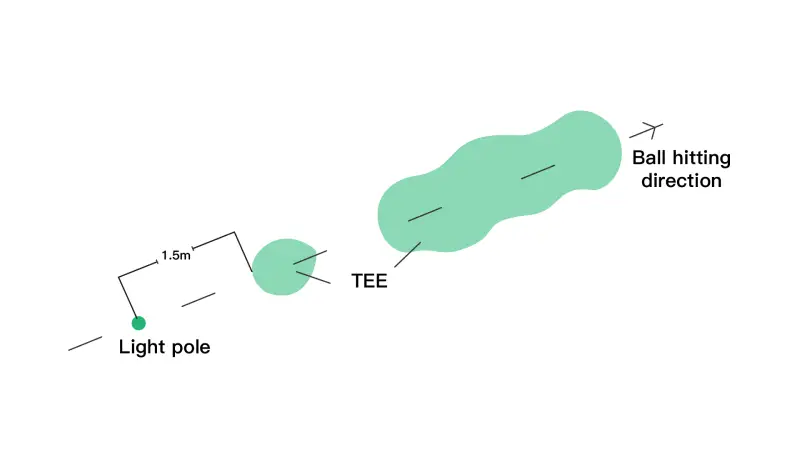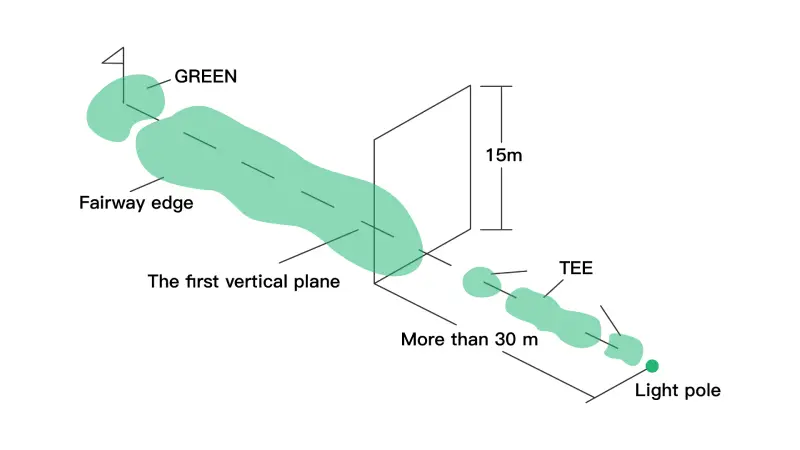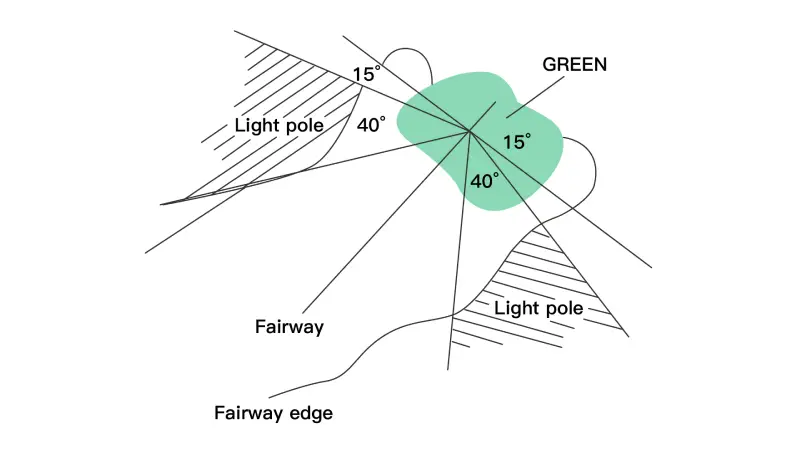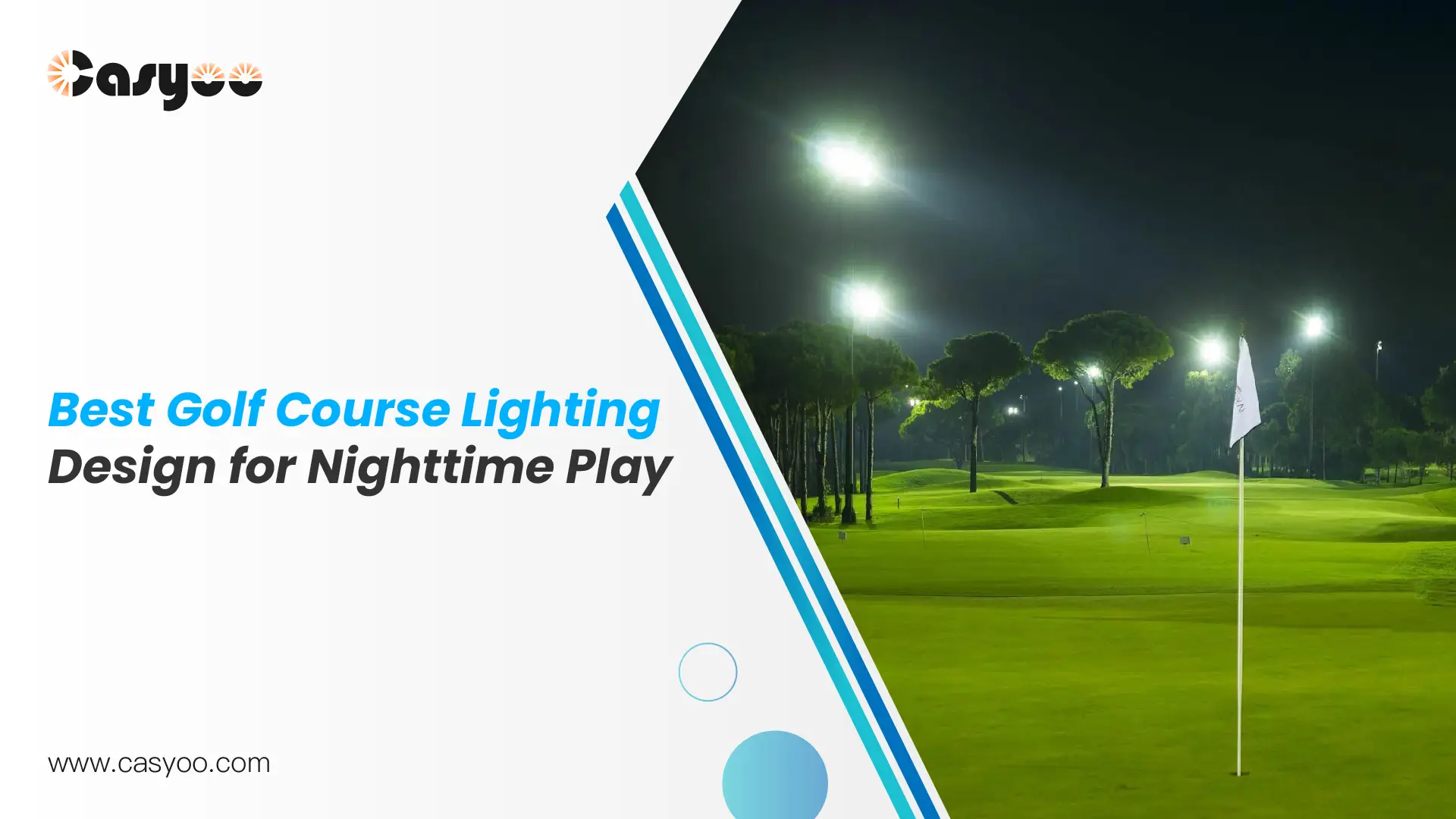Compared to other sports courses, the golf course is larger and has many fairways. The terrain varies in several ways, with ups and downs, making the golf course lighting design much more complicated. Yet lighting is the key to ensuring players’ experience during nighttime play. Therefore, you definitely need to read this passage to know how to achieve the best lighting design for golf courses!
Lux level of golf course lighting
A golf course is mainly composed of three parts: Tee, Fairway, and Green, and the illumination requirements of each area are different.
1. Tee
(1) The average horizontal illumination value in the main teeing area should be above 150Lx.
(2) The vertical illumination of the teeing area within a height of 30m:
a. Behind the main teeing area: above 100Lx
b. In front of the teeing area: above 300Lx
c. 200m in front of the teeing area: above 150Lx
2. Fairway
Within the total length of the fairway, the horizontal and vertical illumination should be up to standard to provide optimal lighting conditions for the hilly area. The required average horizontal illumination should be above 120Lx, and the average vertical illumination should be above 50Lx.
3. Green
The lighting in Green area should be sufficient and should minimize the shadow of the player’s body when they hit the ball from multiple directions. The average horizontal illumination in this area should be above 250Lx.
How to arrange the light poles at the golf course
Tee
The aim of TEE lighting design is to allow both left- and right-handed golfers to see the ball and the end of the driver’s club well. The recommended lighting fixtures are wide-distribution floodlights, and it is better to illuminate from two directions. This kind of lighting can avoid situations where the shadow falls in the hitting direction or on the ball.
The light pole is typically placed at least 1.5 meters from the back border of the tee. Providing lighting in multiple directions is necessary for larger tees. The height of the light poles should not be shorter than half of the total length of the tee box and at least higher than 9m.

Fairway
The fairway’s width, which has an average width of roughly 41 meters, varies depending on how challenging the game is. Generally, It can range from 32 to 55 meters. A typical fairway curves everywhere around the perimeter and is widest in the landing area. To achieve adequate vertical illumination, consider utilizing narrow-distribution floodlights as tracking lighting from both sides. The reference value for vertical illumination is taken from a plane perpendicular to the center line of the fairway. Its height is approximately 15 meters above the center line, and its length is the entire fairway’s width at that location.
The fairway’s vertical illumination should be sufficient to allow the player to view the ball’s full path until it lands, even at speeds of up to 100 km/h. To this end, it is required that the first vertical plane be no less than 30 meters from the light pole of the tee box. It is preferable to place these lights at the corner of the fairway or the ball landing area, which will decrease the number of lamps needed. The lamp’s minimum installation height is 11 meters from its base. Light poles are typically placed along golf lanes or on higher ground to lessen the effect of the terrain.

Green
The Green has very high requirements for horizontal illumination, and the maximum to minimum horizontal illumination ratio should not be greater than 3:1. On a golf course, where players can hit the ball in any direction toward the hole, lighting should come from at least two directions in order to reduce shadows. The installation area is the 40-degree shadow zone in front of the green area. The maximum spacing between the lights is three times the pole’s height.

What to consider for the best golf course lighting
- Reduce glare: There are four types of glare that need to be considered: direct, reflected, sharp contrast, and caused by visual discomfort. For fairways adjacent to each other, direct glare is very likely to occur. When the golfer is at a certain distance from the light source, appropriately increasing the height of the glare source can reduce the glare. Experience has shown that glare can be more effectively controlled when the light source is higher than 11 meters.
- Select light sources that have a high color temperature and CRI. The original colors of lawns, balls, etc. can be reproduced using a light with a color temperature of 5500K or above and a CRI of greater than 90.
- Selection of light poles: Common types of light poles include fixed, tilting, pneumatic lifting, and hydraulic lifting. Besides considering your budget, you should choose the pole that will minimize the damage to the natural beauty of the golf course.
To wrap up
Although the golf course is larger and more complicated than other courses, knowing the standards can help you start the first step in golf course lighting design. Then, considering the characteristics of the golf game and the various terrain, the lighting design can be carried out for the TEE, FAIRWAY, GREEN, and other areas. Since the lighting design is not so easy, you can contact professional manufacturers like Casyoo and then get the specific lighting design effortlessly!




